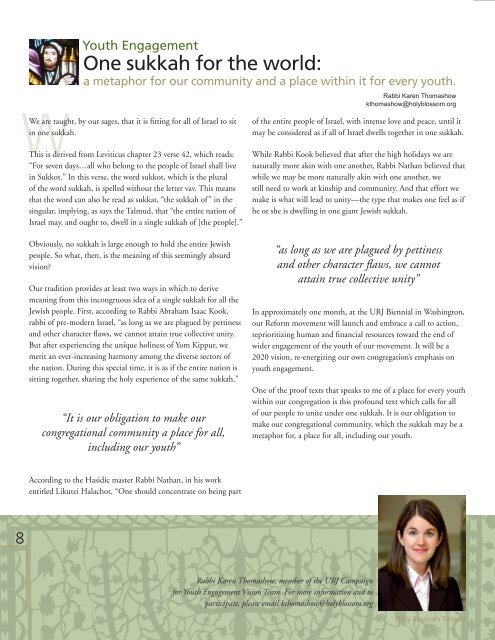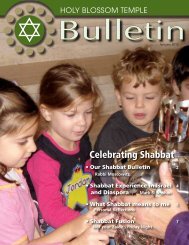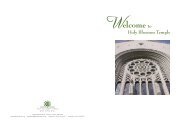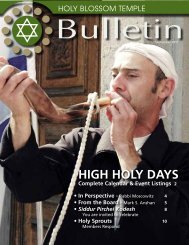Celebrating - Holy Blossom Temple
Celebrating - Holy Blossom Temple
Celebrating - Holy Blossom Temple
Create successful ePaper yourself
Turn your PDF publications into a flip-book with our unique Google optimized e-Paper software.
8<br />
Youth Engagement<br />
One sukkah for the world:<br />
a metaphor for our community and a place within it for every youth.<br />
We are taught, by our sages, that it is fitting for all of Israel to sit<br />
in one sukkah.<br />
This is derived from Leviticus chapter 23 verse 42, which reads:<br />
“For seven days…all who belong to the people of Israel shall live<br />
in Sukkot.” In this verse, the word sukkot, which is the plural<br />
of the word sukkah, is spelled without the letter vav. This means<br />
that the word can also be read as sukkat, “the sukkah of” in the<br />
singular, implying, as says the Talmud, that “the entire nation of<br />
Israel may, and ought to, dwell in a single sukkah of [the people].”<br />
Obviously, no sukkah is large enough to hold the entire Jewish<br />
people. So what, then, is the meaning of this seemingly absurd<br />
vision?<br />
Our tradition provides at least two ways in which to derive<br />
meaning from this incongruous idea of a single sukkah for all the<br />
Jewish people. First, according to Rabbi Abraham Isaac Kook,<br />
rabbi of pre-modern Israel, “as long as we are plagued by pettiness<br />
and other character flaws, we cannot attain true collective unity.<br />
But after experiencing the unique holiness of Yom Kippur, we<br />
merit an ever-increasing harmony among the diverse sectors of<br />
the nation. During this special time, it is as if the entire nation is<br />
sitting together, sharing the holy experience of the same sukkah.”<br />
“It is our obligation to make our<br />
congregational community a place for all,<br />
including our youth”<br />
According to the Hasidic master Rabbi Nathan, in his work<br />
entitled Likutei Halachot, “One should concentrate on being part<br />
Rabbi Karen Thomashow<br />
kthomashow@holyblossom.org<br />
of the entire people of Israel, with intense love and peace, until it<br />
may be considered as if all of Israel dwells together in one sukkah.<br />
While Rabbi Kook believed that after the high holidays we are<br />
naturally more akin with one another, Rabbi Nathan believed that<br />
while we may be more naturally akin with one another, we<br />
still need to work at kinship and community. And that effort we<br />
make is what will lead to unity—the type that makes one feel as if<br />
he or she is dwelling in one giant Jewish sukkah.<br />
“as long as we are plagued by pettiness<br />
and other character flaws, we cannot<br />
attain true collective unity”<br />
In approximately one month, at the URJ Biennial in Washington,<br />
our Reform movement will launch and embrace a call to action,<br />
reprioritizing human and financial resources toward the end of<br />
wider engagement of the youth of our movement. It will be a<br />
2020 vision, re-energizing our own congregation’s emphasis on<br />
youth engagement.<br />
One of the proof texts that speaks to me of a place for every youth<br />
within our congregation is this profound text which calls for all<br />
of our people to unite under one sukkah. It is our obligation to<br />
make our congregational community, which the sukkah may be a<br />
metaphor for, a place for all, including our youth.<br />
Rabbi Karen Thomashow, member of the URJ Campaign<br />
for Youth Engagement Vision Team. For more information and to<br />
participate, please email kthomashow@holyblossom.org<br />
<strong>Holy</strong> <strong>Blossom</strong> <strong>Temple</strong>







